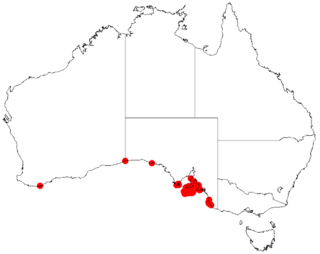
Scaevola aemula, commonly known as the fairy fan-flower or common fan-flower, is a species of flowering plant in the family Goodeniaceae. It has mostly egg-shaped leaves and blue, mauve or white fan-shaped flowers. It grows in New South Wales, South Australia and Victoria.

Pterocaulon sphacelatum, commonly known as apple bush or fruit-salad plant, is a species of flowering plant in the family Asteraceae. It is an upright shrub with mostly pink to purple flowers and is endemic to Australia.

Scaevola hookeri, commonly known as the creeping fan-flower or alpine fan-flower, is a species of flowering plant in the family Goodeniaceae. It has white or blue flowers with a yellow throat and grows in eastern Australia.

Goodenia hederacea, commonly known as forest goodenia or ivy goodenia, is a species of flowering plant that is endemic to eastern Australia. It is a prostrate to ascending, perennial herb with linear to elliptic or round leaves, and racemes of yellow flowers.

Scaevola albida, commonly known as pale fan-flower or small-fruit fan-flower, is a flowering plant in the family Goodeniaceae. It is a spreading perennial herb with pale blue or white fan-shaped flowers and obovate leaves. It grows in Queensland through eastern New South Wales and coastal areas of Victoria and Tasmania.

Lobelia anceps, commonly known as angled lobelia, is a small herbaceous plant in the family Campanulaceae it grows in several states of Australia, New Zealand, South America and South Africa. It is a small, perennial herb with blue to purple flowers.

Scaevola calendulacea commonly known as dune fan-flower, is a flowering plant in the family Goodeniaceae. It is a small, mat-forming shrub with blue fan-shaped flowers with a yellow centre and grows on sand dunes in eastern and southern Australia.
Goodenia dyeri is a species of flowering plant in the family Goodeniaceae and is endemic to the south-west of Western Australia. It is an ascending herb with egg-shaped, toothed leaves at the base of the plant, with solitary yellow flowers in the leaf axils.
Goodenia glandulosa is a species of flowering plant in the family Goodeniaceae and is endemic to dry, inland areas of Australia. It is an erect, perennial herb with linear to lance-shaped leaves and racemes of yellow flowers.
Goodenia krauseana is a species of flowering plant in the family Goodeniaceae and is endemic to part of Western Australia. It is a prostrate to ascending herb densely covered with silvery bristles, and has lance-shaped leaves at the base, sometimes with a few teeth on the edges, and small groups of yellow flowers with a brownish centre.

Leucopogon attenuatus, commonly known as grey beard-heath, is a species of flowering plant in the family Ericaceae. It has grey-green leaves and small white flowers and grows in New South Wales and the Australian Capital Territory.

Scaevola angustata is a species of flowering plant belonging to the family Goodeniaceae. It has pale blue to purple flowers and is endemic to South Australia.
Scaevola collina, is a species of flowering plant in the family Goodeniaceae. It is a small sub-shrub with blue to purplish flowers. It grows in South Australia.

Scaevola depauperata, commonly known as skeleton fan-flower, is a species of flowering plant in the family Goodeniaceae. It is a small understorey shrub with blue, mauve or cream-white flowers. It grows in mainland states of Australia with the exception of Western Australia.
Scaevola tenuifolia is a species of flowering plant in the family Goodeniaceae. It is a prostrate herb with white to blue flowers and endemic to Western Australia.
Scaevola pulchella is a species of flowering plant in the family Goodeniaceae. It is a small, spreading shrub with blue to mauve flowers borne on terminal spikes and is endemic to Western Australia.

Scaevola parvibarbata is a species of flowering plant in the family Goodeniaceae. It is an upright herb with fan-shaped mauve or greenish flowers and grows in New South Wales, Queensland, South Australia and the Northern Territory.

Scaevola glabrata is a species of flowering plant in the family Goodeniaceae. It is a small, spreading shrub with fan-shaped blue flowers and elliptic to egg-shaped leaves.

Scaevola eneabba is a species of flowering plant in the family Goodeniaceae. It is a small, spreading shrub with fan-shaped white to pink flowers and is endemic to Western Australia.

Scaevola anchusifolia commonly known as silky scaevola, is a species of flowering plant in the family Goodeniaceae. It is a small, upright or decumbent shrub with fan-shaped blue to bluish white flowers and is endemic to Western Australia.















